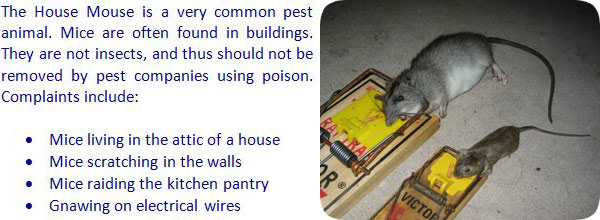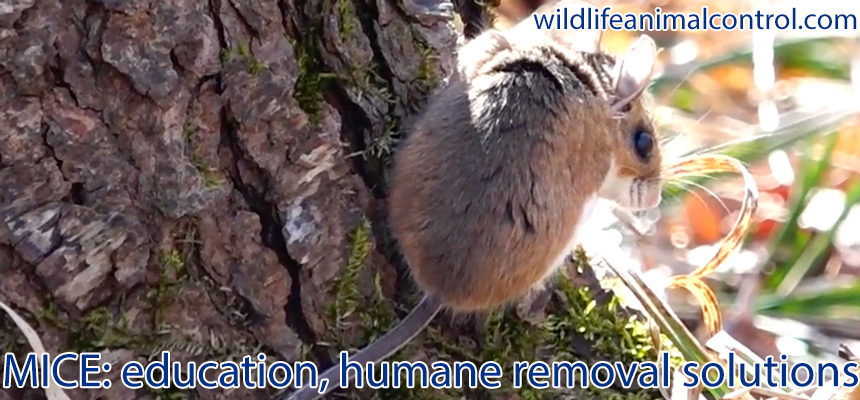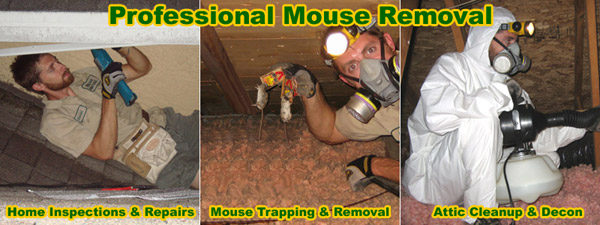- info@wildlifeanimalcontrol.com
Call us for help in your town
Wildlife Control Education
Getting Rid of Mice in the House - How To

We perform mouse removal in over 1700 USA locations - serving the whole USA.
It is my goal to educate the public about mice and other wildlife, and
provide tips for safe, effective, and responsible wildlife removal.
Summary of Step-By-Step Instructions:
1) Inspect inside attic, and ever square inch of the house, for mouse entry holes. These holes can be as small as a dime, or a 1/4" wide gap.
2) Seal shut all entry holes, with steel, BEFORE any trapping or exclusion.
3) Set one-way exclusion funnels on the primary entry/exit holes, or set at least a dozen mouse traps, baited with peanut butter, on the primary mouse trails (marked by droppings and brown grease) in the attic.
4) Once you hear no more mouse sounds at night, the trapping is complete.
5) Clean and decontaminate the attic space.
Need mouse removal in your hometown? We service over 500 USA locations! Click here to hire us in your town and check prices - updated for year 2020.
How to Get Rid of Mice - Mice may seem adorable, but don’t be deceived by their appearance because they can do some serious damage to your home and to your health. Mice are rodents that are much smaller than rats and prefer to live near human habitations. They can be any color ranging from a snowy white to a rusty red or even a dark coal black. They have small features like their eyes, ears and feet and have a long hairless pink tail. While they look cute, you should not think of them as pets that live in your walls and attic, but as rodents that have the ability to destroy your house.

Mice can do considerable amounts of damage to your attic or home and to your health. Mice can squeeze thorough very small openings to gain entry into your house or they can chew their way in. This can destroy your drywall and possibly even start an electrical fire if they accidentally chew through wiring. Mice can also be hazardous to your health because their urine and droppings are toxic. When mice chew into your food pantries they will leave their droppings and urine in your food and you may not even realize it until it’s too late and you, your family or even your pet is sick. However, even though it is easy for mice to get into your house, it is extremely difficult to get them out. If you have an infestation of mice there are some ways to get rid of them successfully.
- One of the easiest and most effective ways to get rid of mice is to call a local exterminator or pest removal service. While it takes some money to go this route, you can rest assured that the professional you hire will solve your problems and spare you all the hassle of trapping or killing them and then relocating them. Some exterminators/pest removal experts will also decontaminate the area where the mice were living.
- Poisons are more effective than using traps, but are more dangerous than any other mouse extermination method. Poisons are toxic to humans, children and pets if they are consumed. Not only are they toxic to us, but they do not kill the mice right away which gives them a chance to go back to the nest and die. This is a problem because the nests are in hard to reach places and the carcasses smell terrible and attract bugs which is another problem all together.
- Traps are the standard method of getting rid of mice, with the snap trap being the most popular choice. Snap traps are inhumane and create a mess if the bar gets the head instead of the neck. Glue traps are very inhumane and the creature will suffer for a very long time before it dies. Live traps are effective by a pain to use and electrical traps seem to be the best all around. You can pick up any or all of these are hardware stores.
- The best way to prevent an infestation of mice or to get rid of an infestation is to keep your house very clean, especially your kitchen. Keeping all your food in glass or metal containers and your trash in stainless steel cans will do wonders in preventing and getting rid of infestations. This goes for outside and your counters also. The logic behind this is that the mice will not stick around if you take away their food source.

More in-detail how-to mouse removal articles:
Information about mouse trapping - analysis and methods for how to trap.
Information about how to keep mice away - prevention techniques.
Information about how to kill a mouse - with poison or other methods.
Information about how to catch a mouse - remove one stuck in the house.
Information about mouse repellent - analysis of types and effectiveness.
What are the house mice mating habits?
The Legality of Trapping House Mice
Will The City or County Animal Services Help Me with a Mice Issue?
Will Homeowner’s Insurance Pay for House Mice Damages?
What to do if a mouse got inside your house
How to inspect a house for house mouse entry holes
How to Keep Mice out of your Garden
How to Keep Mice out of your Garbage
How to use mice one-way exclusion funnels
What equipment to use in trapping a house mouse
What diseases do mice carry?
What is a house mouse’s natural diet?
How to Find and Remove Dead House Mice
What Damages do Mice cause in the Attic?
How mice communicate using pheromones
How to get mice out of your car
Will a mouse in the attic have babies?
What should I do if I find a nest of mice in the attic?
How do you remove a house mouse stuck in a garbage can or other place?
What are some of the symptoms of a sick house mouse?
What do wildlife rehabilitators do with mice?
Should I Ever Poison a House Mouse?
What do mouse feces look like?
The Diseases Caused by Mice Droppings
What is the best bait to trap a house mouse?
About the House Mouse
Will a strobing light of high pitch sound deterrent machine work on mice?
What are the types of house mouse snap traps?
What to do about Trap-Shy Mice
Should you hire a Professional or Remove Mice Yourself?

House Mouse Information & Facts
House Mouse Appearance: The house mouse is a small rodent which usually grows up to four inches long, weighing up to ten ounces. They are most commonly brown or gray in color, though a mixture of pigments, black coloration, or complete loss of pigmentation (albino) are not uncommon. Tails are covered in fine fur and are of equal length to the body. Males and females of the species are similar in appearance with no obvious differences unless closely examined.
House Mouse Habitat and Behavior: Like others of their order, the mouse will live inside human dwellings. This co-existence with people is not purely due to opportunity. House mice in nature have a large source of competition for food in the form of other small mammals and other species of mice. The survival rate in these circumstances is small, which is why it is advantageous for a house mouse to live inside a home. Some mice will choose to live outside a structure, but will always be close enough to reap the benefit of food sources. Within the walls of a house, few predators are an issue, though rats will kill mice and take over their territories. House mice are territorial. Groups consist of a male and up to three females. Males will not enter a territory of another unless it has been abandoned.
Sensitive to light, these animals are active only in dimly lit hours, most often during the night; however, inside the walls of a home where light is not an issue a mouse can be active at any time of day. Pathways created in a territory will be marked with pheromones and scents produced through urine, feces, and tear markings. Relying mostly on smell and ultrasonic sounds to communicate, the mouse also uses its sensitive whiskers to navigate around obstacles and to sense air currents.
In certain climates, the house mouse will reproduce all year round, each female having up to ten litters. Each litter can have up to fourteen offspring, and this abundance of young increases the mouse population very quickly.
House Mouse Diet: The house mouse is an herbivore, and it maintains a diet mostly of grain and fruit. In settings where the mouse lives near humans, the animals will eat most edible, non-meat substances. Vegetables and fruits are a staple of the diet, though, and proper nutrition is not complete without the vitamins and minerals associated with that type of vegetation.
House Mouse Nuisance Concerns: For most rodents, mice included, chewing is not merely a means of creating a nesting site or burrow. Mice must chew to keep their teeth filed to a reasonable length. Teeth that have grown too long will prevent the mouse from eating properly and will ultimately end in starvation. This need to chew makes the mouse a particularly destructive nuisance species. They can chew on almost anything—and will. Electrical cords, wires, drywall, cables, and support boards can all be targets. In addition to chewing, mice leave behind urine and droppings as markers for other mice, and this waste abundance can cause contamination of food or spread a variety of diseases.
House Mouse Diseases: Tularemia, a disease caused by bacteria spread by mice, can be fatal, and is characterize by a fever, skin lesions, and lethargy. Mice also spread leptospirosis, a mammalian bacterium that affects kidney function. Rickettsialpox, similar to chickenpox, is nonfatal, but is most commonly associated with the house mouse. Rodents are responsible for a large number of diseases, though many of them are secondary and caused by contact through fleas, ticks, or other external parasites. It is thought that mice are responsible—directly or indirectly—for thirty-five infectious diseases between humans and animals.
You're here to learn how to get rid of mice in the attic or house or even garage or car. Mice are one of the animals that cause
scratching sounds in the attic or walls. This site is intended to provide mouse education and information, so that you can make an informed decision
if you need to deal with a mouse problem. This site provides many mouse control articles and strategies, if
you wish to attempt to solve the problem yourself. If you are unable to do so, which is likely with many
cases of mouse removal, please go to the home page and click the USA map, where I have wildlife removal experts
listed in over 500 cites and towns, who can properly help you with your nuisance mouse.

















